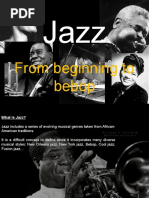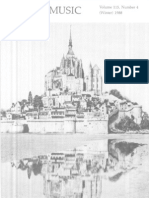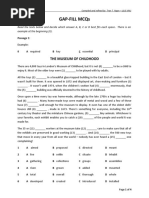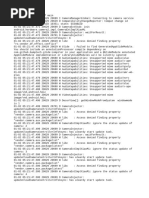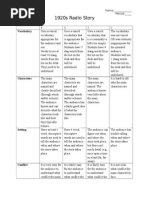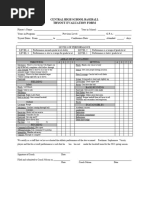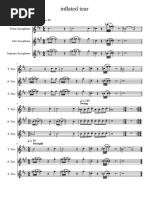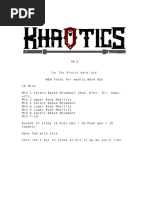Jazzmass 1
Jazzmass 1
Uploaded by
api-124260275Copyright:
Available Formats
Jazzmass 1
Jazzmass 1
Uploaded by
api-124260275Original Title
Copyright
Available Formats
Share this document
Did you find this document useful?
Is this content inappropriate?
Copyright:
Available Formats
Jazzmass 1
Jazzmass 1
Uploaded by
api-124260275Copyright:
Available Formats
A Jazz Mass?
The Vexing Legacy ofMary Lou Williams
Ian Marcus Corbin
ast year marked the thirtieth anniversary of the death of Mary Lou Williams, the jazz pianist, composer, and arranger. There are few women in the pantheon of great jazz instrumentalists, and even fewer jazz performers in the pantheon of great Catholic artists. Williams was both. A pianist of unusual sensitivity and range, she could play almost anythingspirituals and ragtime, blues and swing, boogie-woogie and bop. Over her long career she made dozens of records, played with virtually all the most important jazz artists, and heard her compositions and arrangements performed by the likes of Duke Ellington and Benny Goodman. "Her music maintains a quality that is timeless," Ellington once said. "She is like soul on soul." Williams's long, remarkable life contained a number of surprises, none more significant than her conversion to Catholicism. In 1957, following a half-decade of self-taught ascetic religious practice, she was baptized along with her friend Lorraine Gillespie, wife of the trumpeter Dizzy Gillespie, and became a sort of apostle to jazz musicians, many of whom were wracked with addiction to drugs. Jazz, Williams believed, was fundamentally a music of healing, and she was determined to employ her gifts in the service of God and neighbor. Central to her new sense of mission was the composition of a jazz Mass, and in the coming years she would complete three of them. One, composed in honor of Martin Luther King Jr. after his 1968 assassination, was scheduled to be celebrated in Rome in February 1969, but was cancelled at the last minute when the vicariate realized that the setting included bongo drums. But Williams persevered, and later that year she received a commission from the Pontifical Commission on Justice and Peace to compose her third Mass, called Musicfor Peace (now commonly known as "Mary Lou's Mass"). As the 1970s began, Williams turned her energy to the task of seeing this Mass celebrated in a symbolic center of Catholicismeither St. Peter's Basilica or New York's St. Patrick's Cathedral. To her Catholic friends and boosters, a the compositiona bright and exuberant romp through t various jazz styles, along with some pop-rock and funk I t Ian Marcus Corbin is a graduate student in philosophy at Boston College.
tingesseemed the perfect liturgy for a new post-Vatican II Catholicism, an ebullient departure from stiff, musty Eurocentrism. But many clerics Williams approached expressed serious reservations. Church leaders in both Rome and New York repeatedly offered to stage recitals of the piece, but declined to accept it as a setting for the Mass. Doggedly undeterred, Williams approached New York's Cardinal Terrence Cooke (she would later recount chasing him across the campus of Fordham University), who assented, hoping such a move could help draw young people back to the church. In February 1975, "Mary Lou's Mass" was finally celebrated, and Williams left St. Patrick's in raptures. This breakthrough did not, however, mark the dawn of a new era. Williams's repeated attempts to have her composition performed as a Mass in the Vatican were unsuccessful and thirty-seven years later jazz remains, at the very best, on the periphery of liturgical music in America. This fact needs some explaining, because, as Williams always insisted, jazz is the only serious art form created exclusively in America. And it is indeed serious art; the highest achievements of jazz belong to the first tier of great Western music. So why hasn't jazz found a more central place in the liturgical life of the Catholic Church in America?
13
o
14
Williams herself chalked it up to racial or cultural preju- or Coltrane's. Jazz that lacks this personality feels stilted and dice. Church leaders, she believed, thought ofjazz as "pagan contrived; it is not, in other words, great jazz. Insofar as jazz music" and were not willing to grant blacks a prominent invites participation at all, it is of a passive spiritual sort, place in the church. She was right to be frustrated. While and it is a very serious question whether such participation many church leaders balked at the idea of a jazz liturgy, is ideal for a communal celebration like the Mass. they generally failed to provide good, principled reasons for Moreover, jazz is finally a humanistic art. Its grandeur their reticence. The church's lies in exploring the tragedies, overall response to her artistic triumphs, and spiritual longofferings was inarticulate and ings of human life. By way evasiveas if it were self-evof contrast, the composiident that bongo drums and At its best, jazz is always tions of Bach or Palestrina, Catholicism were mutually or the contemporary Estonian individual and personal. exclusive. composer Arvo Part, aspire There are defensible reaWe are moved not so much to touch the hem of great sons for this exclusion, even if religious mysteries, to limn by the composition of few churchmen of Williams's in sound a shadow of tranday were willing or able to "My Funny Valentine" as by scendence. These works fit articulate them. Briefly put, with the Catechism's underthe5pontaneous, particular, a great jazz performer like standing of sacred art, whose Mary Lou Williams is an irreplaceable overflow of feeling task is "evoking and glorifyexemplary specimen of the ing, in faith and adoration, in the performances of Miles artist as heroic individual. the transcendent mystery of This individualism is not of Davis, Mary Lou Williams, or God." Very little modern the isolating sort bemoaned art fits this description, and John Coltrane. by all serious observers of neither does the music of America since Tocqueville, Mary Lou Williams. What but rather a more romantic Williams accomplishes is to and ultimately communal open her soul to the listener, sort. Joseph Conrad, in his celebrated preface to The Nig- offering spiritual friendship; the final goal is interpersonal ger ofthe Narcissus, put forth a vision of the artist as one who communion, not communion with the divine. It is a music descends to the "lonely region" within himself, in order to of earth, not of heaven. study and then speak to one of this negates the greatness of jazz as an art our capacity for delight and wonder, to the sense of mystery form, or the real affinity that exists between the surrounding our lives; to our sense of pity, and beauty, and Catholic vision of reality and the profound, searchpain; to the latent feeling of fellowship with all creation ing, spiritually hungry creations of Mary Lou Williams. and to the subtle but invincible conviction of solidarity What's more, such affinity can and should open the door that knits together the loneliness of innumerable hearts: to to real friendship and collaboration. In 2009 Pope Benedict the solidarity in dreams, in joy, in sorrow, in aspirations, in XVI invited a group of prominent contemporary artists to the Ulusions, in hope, in fear, which binds men to each other, Sistine Chapel and, quoting Pope Paul VI, told them, "We which binds together all humanity. need your collaboration in order to carry out our ministry, which consists, as you know, in preaching and rendering The chief healing power ofjazz, as recognized and dem- comprehensible and accessible to the minds and hearts of our onstrated by Williams, is a power of precisely this sort. It people the things of the spirit, the invisible, the ineffable, emerges when an artist feels the ugliness and beauty of life the things of God himself" and translates the feeling into melody, harmony, and rhythm. Lovely words, and welcome. But to whom could they be The sensitive listener hears all this and feels that she is realistically addressed? How many practitioners of cuttingnot alone. But for all the deep fellow-feeling that jazz can edge contemporary art could ever fathom taking "the things inspire, it is always, at its best, individual znd personal. We of God himself" as their subject matter? The rift Benedict are moved not so much by the composition of "My Funny hopes to heal is deep, and grew deeper over the second half Valentine" as by the spontaneous, particular, irreplaceable of the twentieth century, as the art world was gradually overoverflow of feeling and expression that it can occasion in the run by aesthetic theories that decreed the primary purpose performances of Miles Davis, Mary Lou Williams, or John of art was to subvert dominant paradigms, whatever and Coltrane. The listener takes in this overflow and allows it to wherever those might be. Today the Catholic Church, a resonate, but it always remains irreducibly Davis's, Williams's, favorite target for this subversive impulse, finds herself in a
Retirement Funtf for Religious >
Like thousands of senior religious. Sister of St. Joseph Rita McNally, 88, has spent her life serving others. Today, she and some 34,000 elder Catholic sisters, brothers, and religious order priests benefit from the Retirement Fund for Religious. Your gift provides funding for prescription medications, nursing care, and more. Please be generous. ~, / *
Share in the Care
To donate: National Religious Retirement Office/CW 3211 Fourth Street NE Washington DC 20017-1194
Make your check payable to Retirement Fund for Religious.
Or give at your local parish.
www.retiredreligious.org
theories of art, the humanistic vision of the artist expressed by Joseph Conrad is hardly more in favor than the one put forth by Pope Benedict. And yet the Conradian vision continues to animate wonderful works of art created by actual artistsand these works continue to speak to intellectually serious, aesthetically sensitive people. This brings us back to the role of artists like Mary Lou Williams. She may not be Bach or Palestrina, but a church that seriously wants to reestablish friendship with contemporary artists would find in her a close ally. Such humanistic art, though earth-bound, opposes a theory-induced aversion to meaning, authenticity, and truth, and stands humbly open to the higher mysteries of existence. Any alliance like the one proposed by Benedict would present challenges. It would require a reimagining of ecclesial art patronage, one that goes beyond the centuries-old custom of commissioning strictly sacred works. But it might repay the effort. Mary Lou Williams was a great Catholic artist who died believing that her church did not value her art. Perhaps someday we will be able to say that Williams simply died too early to see her music fully embraced by the church she loved. If so, those of us still around to see that day might be spared the spectacle of yet another pope inviting yet another group of art-world insiders to the Sistine Chapel, and pleading yet again for the reestablishment of a long-lapsed friendship.
new and uncomfortable position vis--vis the tastemakers of the Western art world. For a thousand years, the church was a principal, in fact the principal, driver of artistic achievement and progress in the West. During that time, most of the greatest composers, painters, sculptors, et al. deployed their skills in the creation of sacred art. Things have changed. The church is now an insurgent, attempting to advance a counterproposal from the margins, one very much at odds with the dominant culture. It's far from clear that she has learned how, exactly, to navigate her new position. The way forward is indeed murky, but one thing seems certain. At a moment when irony, subversion, and nihilistic game-playing are ascendant in much of the art world, beautiful papal speeches will not suffice. Nor will it suffice to focus hopes for an improved future primarily on the most famous artists, the ones who win international acclaim. The Turner Prize, the Venice Biennale, the Booker Prize recognize certain kinds of authentic achievement, but are these anything like what Benedict XVI is calling for? Elsewhere in the same speech, and again quoting Pope Paul VI, Benedict expressed his wish to "reestablish the friendship between the church and artists." If any such rapprochement is to be accomplished in the foreseeable future, the church will need to search painstakingly for signs of life in contemporary art, both within and without the institutional art world. It will not be easy. Among proponents of contemporary
I
o o
15
Copyright of Commonweal is the property of Commonweal and its content may not be copied or emailed to multiple sites or posted to a listserv without the copyright holder's express written permission. However, users may print, download, or email articles for individual use.
You might also like
- Building The Bikini Body 4.0Document47 pagesBuilding The Bikini Body 4.0jayafeb692100% (2)
- New Cult of Sex and AnarchyDocument15 pagesNew Cult of Sex and AnarchyJesse Walker100% (2)
- Asset Practice Worksheet - 1Document5 pagesAsset Practice Worksheet - 1Shikha BhumaNo ratings yet
- Into the Mystic: The Visionary and Ecstatic Roots of 1960s Rock and RollFrom EverandInto the Mystic: The Visionary and Ecstatic Roots of 1960s Rock and RollRating: 3 out of 5 stars3/5 (5)
- Crossroads and The Myth of The BluesmanDocument9 pagesCrossroads and The Myth of The BluesmanTay StevensNo ratings yet
- Boyer - 1979 - tBPiM (Contemporary Gospel Music)Document54 pagesBoyer - 1979 - tBPiM (Contemporary Gospel Music)okorochinenyemodesta2No ratings yet
- Shout, Sister, Shout!: The Untold Story of Rock-and-Roll Trailblazer Sister Rosetta TharpeFrom EverandShout, Sister, Shout!: The Untold Story of Rock-and-Roll Trailblazer Sister Rosetta TharpeRating: 3.5 out of 5 stars3.5/5 (10)
- People Get Ready: Ritual, Solidarity, and Lived Ecclesiology in Catholic RoxburyFrom EverandPeople Get Ready: Ritual, Solidarity, and Lived Ecclesiology in Catholic RoxburyNo ratings yet
- Can't Nobody Do Me Like Jesus!: Photographs from the Sacred Steel CommunityFrom EverandCan't Nobody Do Me Like Jesus!: Photographs from the Sacred Steel CommunityNo ratings yet
- Christianity and “the World”: Secularization Narratives through the Lens of English Poetry 800 AD to the PresentFrom EverandChristianity and “the World”: Secularization Narratives through the Lens of English Poetry 800 AD to the PresentRating: 1 out of 5 stars1/5 (1)
- Good Booty: Love and Sex, Black & White, Body and Soul in American MusicFrom EverandGood Booty: Love and Sex, Black & White, Body and Soul in American MusicRating: 3.5 out of 5 stars3.5/5 (8)
- I Case FOR: Xvi AcknowledgmentsDocument25 pagesI Case FOR: Xvi AcknowledgmentsDarrell MooreNo ratings yet
- Purpose and Parody in Religious MusicalDocument4 pagesPurpose and Parody in Religious MusicalMitchell HollandNo ratings yet
- Ellen White on MusicDocument12 pagesEllen White on MusicgathurukcNo ratings yet
- The Crack Between the Worlds: A Dancer's Memoir of Loss, Faith, and FamilyFrom EverandThe Crack Between the Worlds: A Dancer's Memoir of Loss, Faith, and FamilyNo ratings yet
- An Unexpected Light: Theology and Witness in the Poetry and Thought of Charles Williams, Micheal O'Siadhail, and Geoffrey HillFrom EverandAn Unexpected Light: Theology and Witness in the Poetry and Thought of Charles Williams, Micheal O'Siadhail, and Geoffrey HillNo ratings yet
- Good Music, Sacred Music, & Silence: Three Gifts of God for Liturgy and for LifeFrom EverandGood Music, Sacred Music, & Silence: Three Gifts of God for Liturgy and for LifeNo ratings yet
- No Sympathy for the Devil: Christian Pop Music and the Transformation of American EvangelicalismFrom EverandNo Sympathy for the Devil: Christian Pop Music and the Transformation of American EvangelicalismRating: 3 out of 5 stars3/5 (1)
- Sacred Music, Fall 2011Document65 pagesSacred Music, Fall 2011Church Music Association of America67% (3)
- Mahalia Jackson BiographyDocument7 pagesMahalia Jackson BiographyIda AfsharNo ratings yet
- As Serious As Your Life: Black Music and the Free Jazz Revolution, 1957–1977From EverandAs Serious As Your Life: Black Music and the Free Jazz Revolution, 1957–1977No ratings yet
- The Hidden Face: A Study of St. Therese of LisieuxFrom EverandThe Hidden Face: A Study of St. Therese of LisieuxRating: 3.5 out of 5 stars3.5/5 (3)
- White MusicalWorldHildegard 1998Document12 pagesWhite MusicalWorldHildegard 1998khc49100% (1)
- A Sacred Look: Becoming Cultural Mystics: Theology of Popular CultureFrom EverandA Sacred Look: Becoming Cultural Mystics: Theology of Popular CultureNo ratings yet
- Jazz From Beginning To BebopDocument36 pagesJazz From Beginning To BebopAlexilar Chatte100% (1)
- 2018 Liang Format Translate ArticleDocument4 pages2018 Liang Format Translate ArticleJoNo ratings yet
- Alma LopezDocument20 pagesAlma LopezOlga 'Ligeia' ArnaizNo ratings yet
- Psalms Hymns SongsDocument7 pagesPsalms Hymns SongsmoseschelengaNo ratings yet
- The Sound of Beauty: A Classical Composer on Music in the Spiritual LifeFrom EverandThe Sound of Beauty: A Classical Composer on Music in the Spiritual LifeNo ratings yet
- Howells Requiem CD CoverDocument24 pagesHowells Requiem CD Covergrahammaureen10No ratings yet
- What Is Soul PDFDocument21 pagesWhat Is Soul PDFalamorahoNo ratings yet
- hnexcerpt1223Document4 pageshnexcerpt1223Here & NowNo ratings yet
- Micro and Macro History: Banjo’s Rise and Fall Within White and Black Communities, Sule Heitner.Document11 pagesMicro and Macro History: Banjo’s Rise and Fall Within White and Black Communities, Sule Heitner.suleheitnerNo ratings yet
- 1936 02 CaeciliaDocument52 pages1936 02 CaeciliaAntonio Valdez AlonsoNo ratings yet
- Lost Chords and Christian Soldiers: The Sacred Music of Arthur SullivanFrom EverandLost Chords and Christian Soldiers: The Sacred Music of Arthur SullivanNo ratings yet
- Sacred Music, 115.4, Winter 1988 The Journal of The Church Music Association of AmericaDocument33 pagesSacred Music, 115.4, Winter 1988 The Journal of The Church Music Association of AmericaChurch Music Association of America100% (1)
- Ruth Crawford'S "Spiritual Concept" 223Document1 pageRuth Crawford'S "Spiritual Concept" 223awfefaNo ratings yet
- Various Authors The Worlds Best Poetry Volume 4Document345 pagesVarious Authors The Worlds Best Poetry Volume 4Syed Adnan HussainNo ratings yet
- Triptych: An Examination of the Manic Street Preachers Holy BibleFrom EverandTriptych: An Examination of the Manic Street Preachers Holy BibleNo ratings yet
- Chasing Bright Medusas: A Life of Willa CatherFrom EverandChasing Bright Medusas: A Life of Willa CatherRating: 5 out of 5 stars5/5 (1)
- Edge of Taos Desert: An Escape to RealityFrom EverandEdge of Taos Desert: An Escape to RealityRating: 4 out of 5 stars4/5 (13)
- A High and Holy Calling: Essays of Encouragement for the Church and Its MusiciansFrom EverandA High and Holy Calling: Essays of Encouragement for the Church and Its MusiciansNo ratings yet
- Of Patriarchs... and Matriarchs, Too. Susan McClary Assesses The Challenges and Contributions of Feminist MusicologyDocument7 pagesOf Patriarchs... and Matriarchs, Too. Susan McClary Assesses The Challenges and Contributions of Feminist Musicologypaulgfeller100% (1)
- SY 20 21 Literature Lesson 7 Genres and Feaures of World LiteratureDocument17 pagesSY 20 21 Literature Lesson 7 Genres and Feaures of World LiteratureChris MarceloNo ratings yet
- Sample Webinar Event BriefDocument3 pagesSample Webinar Event BriefLavander BlushNo ratings yet
- JVC GR-DF450US - PartDocument19 pagesJVC GR-DF450US - PartsilictronicNo ratings yet
- Gap-Fill MCQS: The Museum of ChildhoodDocument4 pagesGap-Fill MCQS: The Museum of ChildhoodenglishclubuNo ratings yet
- 573963905 Ikura de Yaremasu KaDocument62 pages573963905 Ikura de Yaremasu Kasyahril631rilzzNo ratings yet
- (Standing in Southeast Corner of The Lodge) : Canadian ChargeDocument4 pages(Standing in Southeast Corner of The Lodge) : Canadian ChargeJeremy GrossNo ratings yet
- 2023 USATKD Kyorugi Rules - Modified Head ContactDocument12 pages2023 USATKD Kyorugi Rules - Modified Head Contactyoussef mebarekNo ratings yet
- Music 9 RecoveredDocument25 pagesMusic 9 RecoveredHanna DoblasNo ratings yet
- Characteristics of The Luxury Industry's Online Presence in 2011Document4 pagesCharacteristics of The Luxury Industry's Online Presence in 2011KhushbooNo ratings yet
- Classic Music - Schubert For Two PDFDocument3 pagesClassic Music - Schubert For Two PDFAlex ZhangNo ratings yet
- Exercise 9 - Fats and OilsDocument4 pagesExercise 9 - Fats and OilsIrene DecolongonNo ratings yet
- Audio Information and MediaDocument3 pagesAudio Information and MediaChrizzieTaasan100% (7)
- Graco Air Purge Stud Wall Spray ManualDocument4 pagesGraco Air Purge Stud Wall Spray Manualprime_suspectNo ratings yet
- 1920s Radio Story HonorsDocument2 pages1920s Radio Story Honorsapi-242800256No ratings yet
- Varsity Tryout FormDocument1 pageVarsity Tryout FormmandeeleaNo ratings yet
- 2Document31 pages2HãrîNo ratings yet
- Boy Scouts Songs and Yells JamboreeDocument2 pagesBoy Scouts Songs and Yells JamboreeSimellin Cabal Dogoy100% (2)
- Horticulture Question BankDocument3 pagesHorticulture Question BankVivek Ponnusamy100% (4)
- Teachers' Notes: Poetry & PerformanceDocument4 pagesTeachers' Notes: Poetry & PerformanceRona NogalesNo ratings yet
- GTX SpareDocument74 pagesGTX SpareSanthosh BabuNo ratings yet
- inflated_tearDocument1 pageinflated_tearbenjamin.resendesNo ratings yet
- MRP Alpha 26042013Document16 pagesMRP Alpha 26042013v80srikanthNo ratings yet
- An Unexpected Visitor - Sophia (Original)Document3 pagesAn Unexpected Visitor - Sophia (Original)suki chanNo ratings yet
- On The Minute Warm UpsDocument5 pagesOn The Minute Warm UpsorcaNo ratings yet
- Dance PositionsDocument9 pagesDance Positionspaola maeNo ratings yet
- Anita and Me - REP InsightDocument31 pagesAnita and Me - REP InsightM Sridhar BabuNo ratings yet
- Boldheart GuideDocument19 pagesBoldheart GuideKata KadekNo ratings yet
- Civil Sports Court O&M ManualsDocument6 pagesCivil Sports Court O&M Manualsh.hafmechNo ratings yet

































